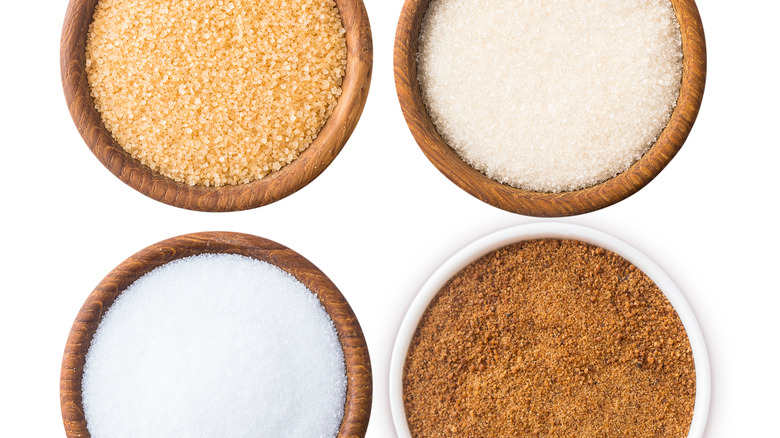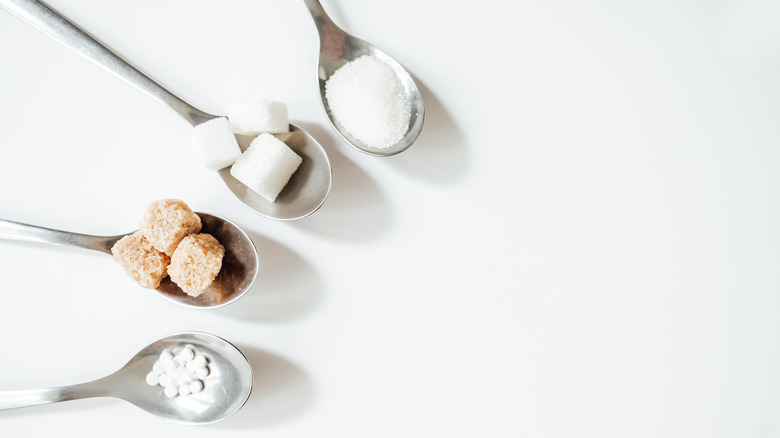The Next Big Thing In Sugar Substitutes Is On Its Way
The search for healthier sugar substitutes is ongoing for clean living and home cooking. As of 2019, Advanced Biotech (ABT) reported that those who use sugar alternatives prioritize natural, organic, non-GMO alternative products, efficiency to assist busy lifestyles, and low-calories options. This combination can be challenging. The latest alternative sugar aiming to meet those needs is tagatose.
Initial studies show that tagatose boasts many qualities as other sugar alternatives because it is low in carbohydrates, non-carcinogenic, and low-glycemic. It also naturally occurs in fruits and dairy, which is good news for health-conscious consumers (via Food Navigator and Calorie Control Council). Even better, tagatose has 92% of sugar's sweetness but only 38% of the calories, reports Food Navigator. This similar taste means that it can act as a sugar substitute. Tagatose also has the texture and consistency of table sugar (via Calorie Control Council).
Tagatose may include prebiotic properties, claims Bonumose, Inc. CEO Ed Rogers. FiGlobal Insights explains that we only partially digest tagatose, and the rest acts as a prebiotic. A study published in BioMed Research International supports Rogers' claims, stating that tagatose offers promising health benefits and has no apparent adverse effects. Furthermore, The U.S. Food and Drug Administration (FDA) considers tagatose as "Generally Recognized as Safe" (GRAS). The FDA also supports the claim that tagatose does not cause tooth decay like other sugars (via Calorie Control Council). On the surface, the future of tagatose looks favorable, but it has had a slow and rocky start.
Tagatose Gets a Boost
Tagatose entered the US market in 2003, and it may seem surprising that it isn't more prevalent. Until recently, producing tagatose was expensive and production efforts generated little yield, making the process both costly and inefficient (via Calorie Control Council). Even so, tagatose has taken off internationally. Other countries, however, including Australia, Korea, and New Zealand, use tagatose as table sugar.
In the fall of 2022, tagatose may get its big break in the U.S. The Virginia-based Bonumose, Inc. plans to introduce tagatose to the mass market with price reductions to offset the high manufacturing cost (per Food Navigator). The Hershey-backed company has patented a more efficient way to produce a higher yield of tagatose. The process reuses food byproducts such as starch left over from making french fries and pea protein, reports FI Global Insights. Furthermore, the applicability of tagatose is good news for Bonumose. Studies show that tagatose enhances flavors such as mint, lemon, and toffee (via Calorie Control Council). Additionally, tagatose also caramelizes. Its versatility and quality taste promise a bright future for the sugar alternative.
Despite its initial setbacks, Bonumose remains optimistic. In 2021, the FDA turned down Bonumose's request to classify tagatose as a dietary fiber. In May 2022, the FDA also denied a request to exempt tagatose from nutrition facts panels under "total and added" sugars (per Food Navigator). That said, tagatose's impressive benefits as an ingredient could soon make it a significant presence in the alternative sugar market.

